#Regent of the Netherlands
Text
Margaret of Austria's Table at the Court of Savoy, Mechelen
Laid Table by Nicholaes Gillis, 1611 (Photo credit: https://www.wga.hu/frames-e.html?/html/g/gillis/laidtabl.html)
When Maximilian I, Holy Roman Emperor, designated his daughter Margaret of Austria as his procurator of the Netherlands, she bought a complex of buildings in Mechelen located across the street from the home of his grandchildren, the son and daughters of Margaret’s brother, Philip…
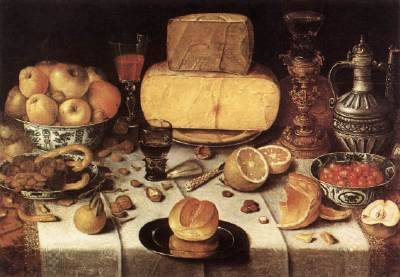
View On WordPress
#Anne Boleyn#Burgundian history#Charles V#Court of Savoy#Duchess of Savoy#Habsburg#Holy Roman Emperor#Low Countries#Margaret of Austria#Maximilian I#Mechelen#medieval history#Netherlands#Regent of the Netherlands#Women’s history
1 note
·
View note
Text



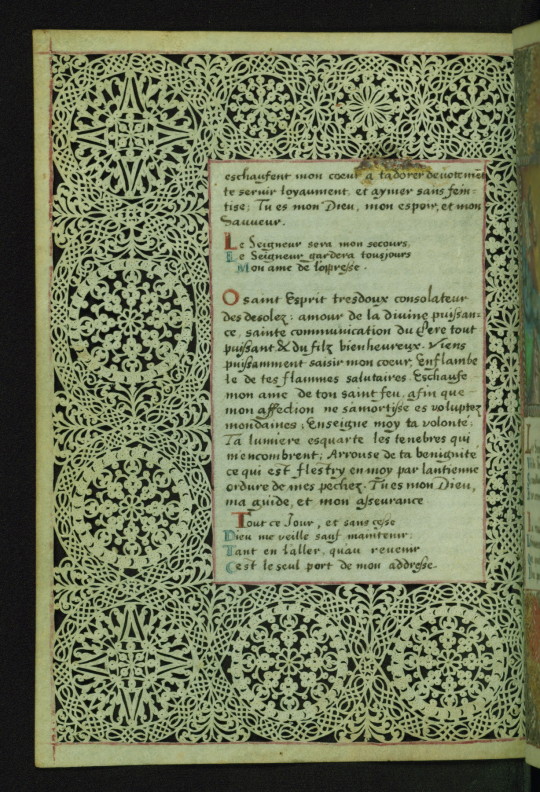


Lace Book of Marie de' Medici, Transfiguration
This Prayerbook was made for Marie de' Medici in the second quarter of the seventeenth century. Beyond its provenance as a personal book owned by the famous queen, it is exceptional for its intricately cut borders, which transform the parchment margins into lace. This effect was created using a technique known as "canivet," in which a small knife was used to cut ornate patterns into paper or parchment. An art form that flourished originally among nuns in France, Germany, and the Netherlands beginning in the sixteenth century, it was employed to exceptional effect in several manuscripts connected with Marie de' Medici. The Walters manuscript, made for her while she was regent of France, and wife of King Henry IV, contains twenty-eight miniatures, including original religious imagery as well as several later additions: a gouache portrait of the elderly queen, and nine small miniatures produced in Bruges ca. 1450 by an artist influenced by the Eyckian and Gold Scrolls styles prevalent at the time; the coat-of-arms of Marie de Medici, as well as her monogram. The Walters manuscript retains its original binding composed of mosaic inlays in green and black leather, as well as fine gilt pointillé foliate tooling, and a replica of the binding was created by Léon Gruel for Henry Walters on one of his seventeenth-century printed books (92.467) that also connects to Marie de' Medici.
Walters Museum Manuscript Department
269 notes
·
View notes
Text
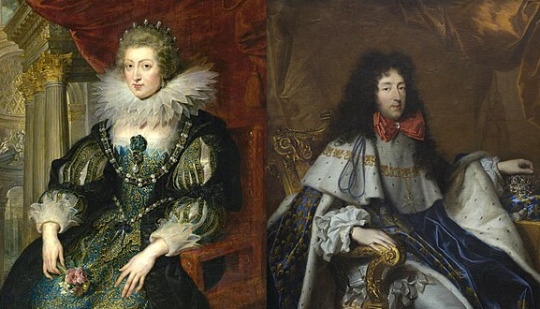
Anne:
Was a spanish habsburg born in Valadolid and, as such, princess of the Netherlands. Cause why not. She did the regency for her son Louis XIV until he became of age.
Philippe:
Gay but like not in a comical way. However also like openly gay, which is uncommon for the time but also YOU go tell the king that his brother is a disgrace and should be more discreet.
He isn't a regent or anything but he is a Bourbon, brother of the king, def gay, and founder of the house of Orléans, who are big phony usurpers and deserves to be in this bracket as such.
22 notes
·
View notes
Text
I'm begging you, please motivate me.
Bow Before the Lord of Spring – Jan's marooning on Kiku's beaches from the shipwreck of the dutch ship de Liefde that changed the destiny of two nations through his first return to the Netherlands. Featuring scurvy, a love born of mutual kindness, yuzu, a feral cat of a nation, the jade stalk going through the back jade gate and linguistic romance.
An Axe of Danegeld – The Viking time travel fic where Alfred knocks himself back too the 9th century. Featuring Matt being mistaken for Vinland and making good on his those rusty axe skills, the bastardization of medieval magic, Magnus on beserker mushrooms, Viking-age child Arthur, and Alfred trying to do wormhole math on trees and meeting his namesake.
The Song of Eirian – The life and death of Britannia with the invasion of the Jutes, Angles and Saxons in the 5th century featuring a portrait of life in the so-called 'Dark Ages,' Brighid's reign as regent, Alasdair attempting to engineer a different fate, Rhys doing his duty and baby Arthur's inability to ever remember his cloak and what it means to love and what it means to die as a nation.
Mother of Exiles – Brighid's odyssey from penal-era Australia to the fever sheds of 1840s Toronto and a final bit of peace in Boston, Massachusetts. Featuring typhus, coffin ships, the Irish diaspora shaping the sons of the British and how the true courage of a nation is in its compassion.
At the End of the Blade – Matt wakes up in a morgue with more holes in him than a block of swiss featuring Arthur committing crimes humanity Alfred tries to solve a murder and what justice means when the victim cannot die.
61 notes
·
View notes
Text


Mary of Hungary, Queen of Hungary 1516-1526, Governor of the Netherlands 1531-1555
Called mannish for "her authoritarian manner, her overly public life and her 'masculine' activities".
Carlos II, King of Spain, reigned 1665-1700
Caused a succession crisis, but not intentionally.
from anon:
"-patron of the arts! had some very good court painters - claudio coello, luca giordano, and juan carreño de miranda
-appointed capable ministers like medinaceli and oropesa
-loved his first wife marie-louise d'orléans very much
-was a silly funny little guy who liked to play harmless pranks on his courtiers
-listen we know the whole succession crisis was a clusterfuck but it was NOT carlos's fault!!! he tried his best to navigate through it and the first candidate he picked (joseph ferdinand of bavaria) was actually a good choice but he died in 1699 so carlos had to fucking go all the way back to square ONE and he knew he couldnt please everyone with his choice
-had a very funny episode of teenage rebellion when he allied with his bastard brother don juan of austria against his own mother the queen regent"
from @master-of-the-opera-house:
Intersex icon 💛💜
No heirs but spawned countless memes inaccurate or not we all have him to thank <3
Mentally eel girlies rep
Historians still get him wrong: scapegoat for everything going into shit when it really was just the snowballed problems of monarchy and generations of inbreeding he did not have agency in like literally everyone was inbred anyway
He was NOT totally incapable of ruling and NOT a puppet king
Extremely poor little meow meow-core
Emo goth girlies rep
Nice hair at least for a while
18 notes
·
View notes
Note
hang on. there is actually a station in london called pancreas?? is it on the red line too this is very important information
i'm not a Londoner, nor from the UK, I don't know if it's on the red line. 😭😭 The only thing I know is that it's the terminus for the Eurostar, coming from Paris. @emmalovesfitzloved could help you with this one.
this is what I found on wiki.
"St Pancras railway station (/ˈpæŋkrəs/), officially known since 2007 as London St Pancras International, is a central London railway terminus on Euston Road in the London Borough of Camden. It is the terminus for Eurostar services from Belgium, France and the Netherlands to London. It provides East Midlands Railway services to Leicester, Corby, Derby, Sheffield and Nottingham on the Midland Main Line, Southeastern high-speed trains to Kent via Ebbsfleet International and Ashford International, and Thameslink cross-London service to Bedford, Cambridge, Peterborough, Brighton, Horsham and Gatwick Airport. It stands between the British Library, the Regent's Canal and London King's Cross railway station, with which it shares a London Underground station, King's Cross St Pancras."
7 notes
·
View notes
Text


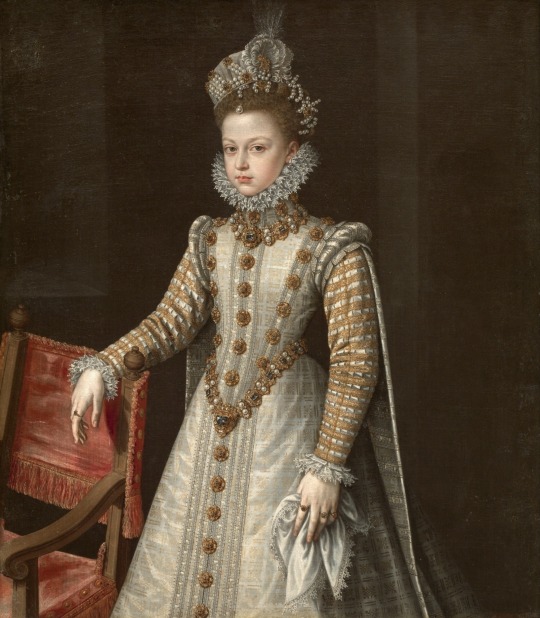

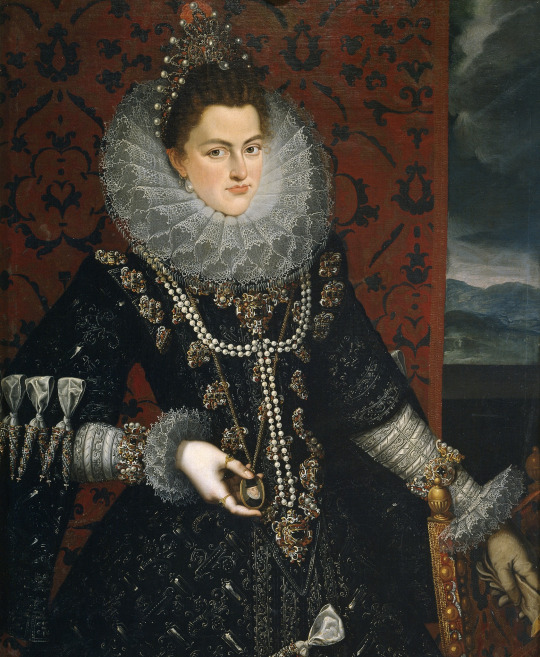

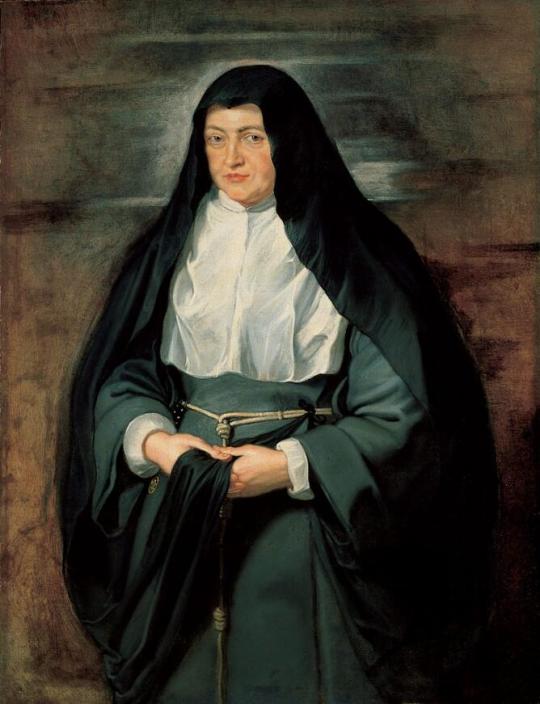

The Infanta Isabella Clara Eugenia (Spanish, 1566-1633): Sovereign of the Netherlands, Duchess of Lothier, Brabant, Limburg, Luxemburg, and Guelders, Margravine of Namur, Countess Palatine of Burgundy, Countess of Flanders, Artois and Hainaut. [source]
1. Attributed to Alonso Sánchez Coello (1531-1588) and Workshop, Isabella Clara Eugenia and Catharina, Daughters of Philip II, King of Spain, c. 1569-70, oil on canvas; The Royal Collection Trust, Green Drawing Room, Buckingham Palace.
2. Alonso Sánchez Coello (Spanish,1531-1588), The Infantas Isabel Clara Eugenia and Catalina Micaela, circa 1575, oil on canvas, Museo del Prado, Madrid.
3. Alonso Sánchez Coello (Spanish, 1531-1588), Infanta Isabella Clara Eugenia, 1577, oil on canvas, Museo del Prado, Madrid.
4. Alonso Sánchez Coello, The Infanta Isabella Clara Eugenia and Magdalena Ruiz, 1586, oil on canvas, Museo Nacional del Prado, Madrid.
5. Juan Pantoja de la Cruz (Spanish, 1553-1608), The Infanta Isabel Clara Eugenia, 1598-99, oil on canvas, Museo del Prado, Madrid.
6. Frans Pourbus the Younger (Flemish, 1569-1622), The Infanta Isabella Clara Eugenia, Archduchess of Austria, c. 1598-1600, oil on canvas.
7. Peter Paul Rubens and Workshop (Flemish, 1577-1640), Portrait of Archduchess Isabella Clara Eugenia, Spanish Regent of the Low Countries, as a Nun, 1625, oil on canvas.
8. Anthony van Dyck (Flemish, 1599-1641), The Infanta Isabella Clara Eugenia, c. 1630, oil on canvas, Walker Art Gallery.
Infanta Isabella Clara Eugenia (Spanish, Segovia, 1566 - 1633, Brussels) was the daughter of Philip II of Spain and his third wife, Elizabeth of Valois, who died after a miscarriage when the Infanta was only two. Her sister Catalina Micaela was one year younger.
She became the sovereign of the Spanish Netherlands in the Low Countries and the north of modern France with her husband, Archduke Albert VII of Austria. She was one of the most powerful women in Europe at the time. The couple had no children. She joined the Sisters of St. Clare order after her co-regent's death.
#infanta isabel clara eugenia#spanish royalty#powerful women#alonso sánchez coello#juan pantoja de la cruz#frans pourbus the younger#peter paul rubens#anthony van dyck#16th century#17th century#european history
34 notes
·
View notes
Text


The Official Launch Party of Carlton Cannes, a Regent Hotel
(first photo by Nick Hayman )
25 notes
·
View notes
Photo

Abraham de Vries - Regents of the city orphanage in Amsterdam - 1633
In the background, the "binnenvader" is leading a young girl to meet the regents. She is clothed in the characteristic orphan dress. From left to right, the regents are: Gerrit Pietersz. Schaep, Gerbrand Claesz. Pancras, Nicolaes van Campen, Frans de Neve, Cornelis Jacobsz. Wayer, Nicolaes Hasselaer.
Pictured in the group portrait are the regents who were responsible for the major renovation of the Burgerweeshuis orphanage in Amsterdam during the years 1630-1634. The arrangement of the composition is very original: de Vries split the regents in two groups: one group on the left-hand side is composed of standing figures and the other on the right-hand side consists of sitting figures. In the background in the middle of the composition a member of staff of the orphanage leads a small orphan girl into the room and thereby links up the two groups. Abraham de Vries may have been the first artist to introduce a child as an "attribute" in a regents group portrait.[6] The portrait of the regents is still ‘’in situ’’ on the wall for which it was designed in the regent's room of the orphanage.
oil on canvas, height: 257 cm (101.1 in); width: 401 cm (13.1 ft)
Amsterdam Museum, The Netherlands
Abraham de Vries (ca.1590–1649 or 1650) was a Dutch painter who was one of the leading portraitists of his age. As he led a peripatetic lifestyle and worked in France, Antwerp and the Dutch Republic his stylistic qualities are difficult to pin down.
32 notes
·
View notes
Text
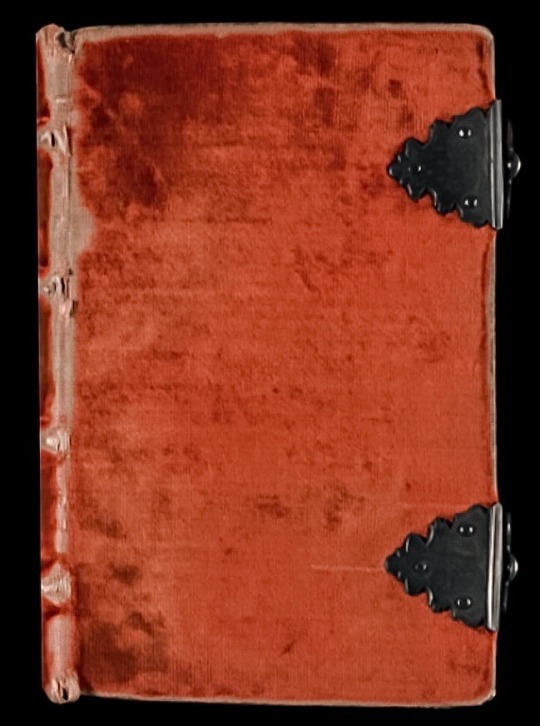
THE SFORZA HOURS (1490-1520) is one of the finest surviving Renaissance manuscripts. It is a Book of Hours — a volume designed for private use, containing the prayers and offices to be said at eight times of the day allotted by the church for prayers. The pages are small, designed to be carried by the owner.
The lavish decorations were painted in two stages: the first around 1490 for Bona Sforza, widow of Galeazzo Sforza, Duke of Milan, and the second for her nephew's widow, Margaret of Austria, Regent of the Netherlands, who inherited the manuscript in 1504. Giovan Pietro Birago, Bona Sforza's miniaturist, had completed and delivered part of the book when a substantial part of the remainder was stolen, never to be returned. Thirty years later, Margaret of Austria commissioned Gerard Horenbout to paint 16 additional miniatures to fill the gaps.
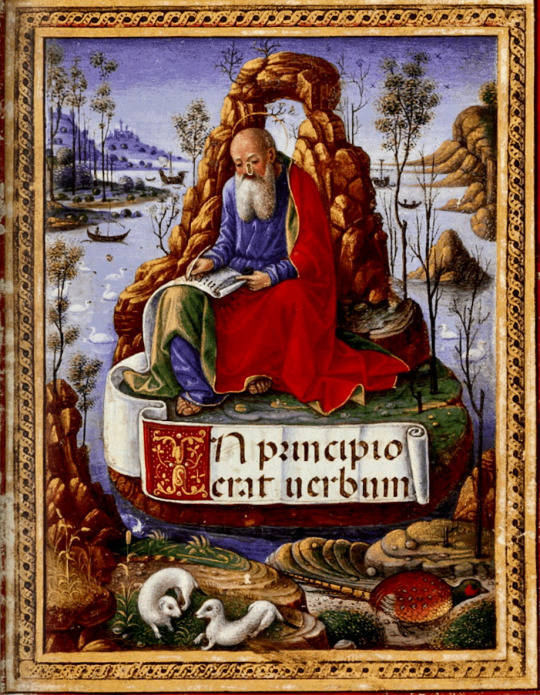
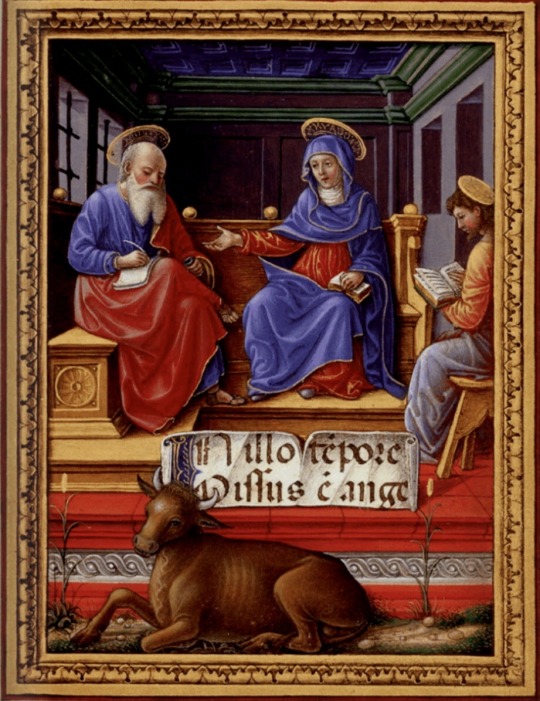
.

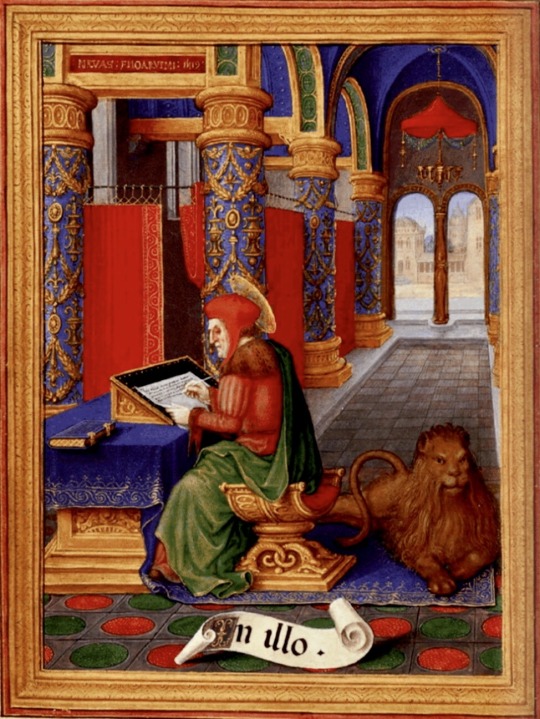
.
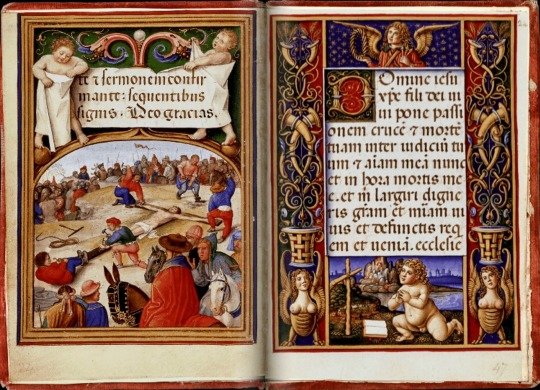
.
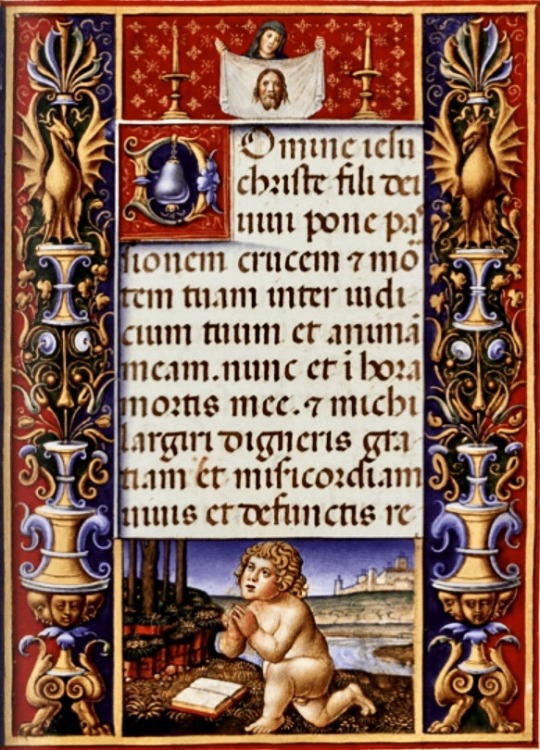

.
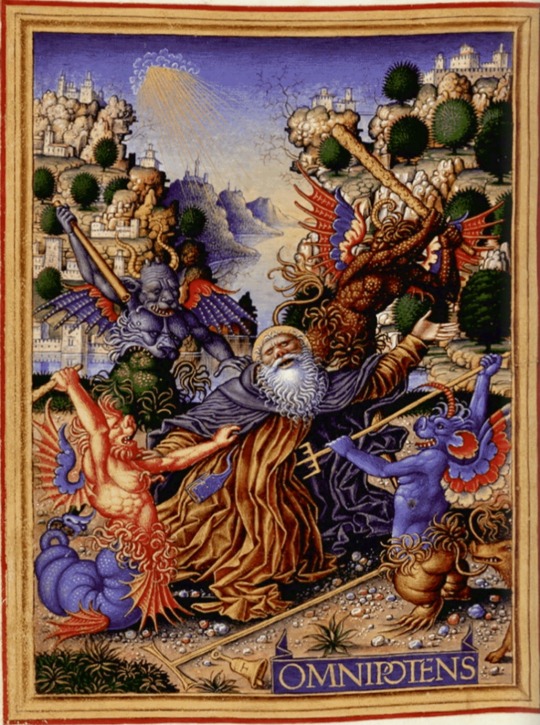

source
#beautiful books#book blog#books books books#book cover#books#illustrated book#book of hours#illuminated manuscript#old books#renaissance#book binding
48 notes
·
View notes
Note
What is some good Netherlandish music that I can listen to on Spotify?
all of a sudden i am ambassador to non dutch ppl interested in the netherlands! my impact!
this entirely depends dear reader, on what you hope to gain from this. i wouldn’t be able tell you whats good for learning dutch, but I can tell you some songs I enjoy and that’s enough. I’m assuming you mean songs in Dutch, and I will not be including songs I suspect of being Flemish due to your wording.
Bitterzoet- Eefje de Visser
De Diepte- S10
Zondagskind- S10
Goud- Froukje
Ik wil dansen- Froukje
Groter dan ik- Froukje
Dans mij naar huis- S10
Sterrenstof- De jeugd van tegenwoordig
Ja Ja Nee Nee- Goldband
Noodgeval- Goldband
Superlatieven- MEROL
Bitterzoet- BLØF
Later als ik groter ben- BLØF
Sexy als ik dans- Nielson
Bliksem- Nielson
Beauty en de brains- Nielson
Het regent zonnestralen- Acda en de munnik
Brabant- Guus Meeuwis (this one makes me a proud resident of brabant btw. i am australian.)
Hemel en Aarde- Edsilia Rombley
Alles is liefde- BLØF
#I would make a playlist but im not comfortable sharing my Spotify so publicly#but yeah hopefully there’s something for everyone here#if you want songs that are kinda more… joke-y come back i just didn’t wanna throw links rechts and kerst met de fam onto you#and if you want dutch songs in english… well… chef’special#anyways i could go on but i am stopping#thanks for asking!#dutch music#also anyone is welcome to add in the tags
13 notes
·
View notes
Text
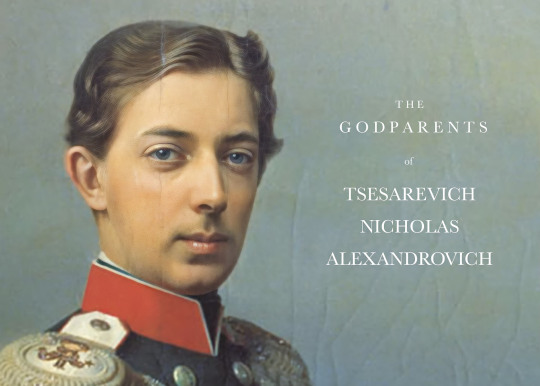
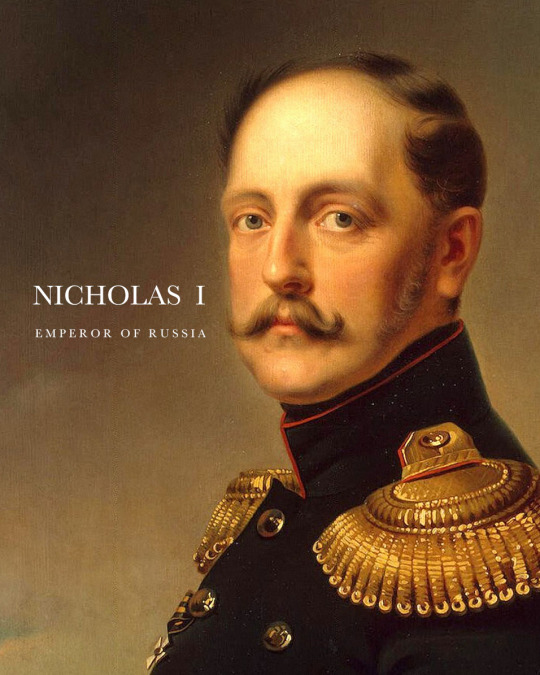
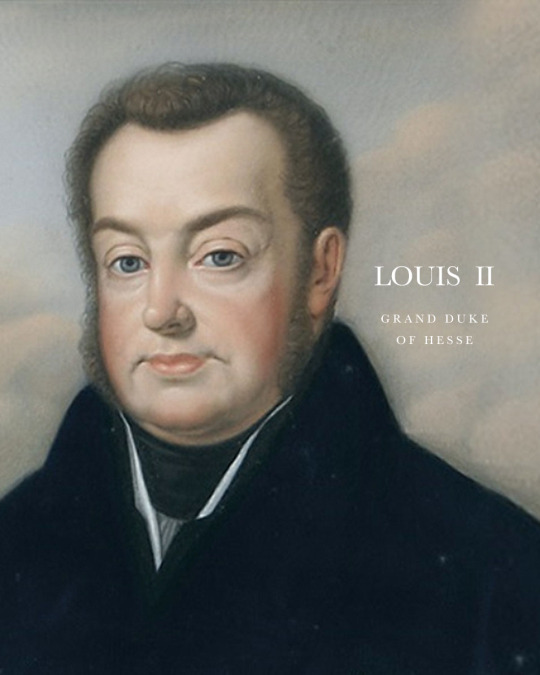


GODPARENTS OF TSESAREVICH NICHOLAS ALEXANDROVICH
Tsesarevich Nicholas Alexandrovich was born as Grand Duke of Russia during the reign of his formidable grandfather Emperor Nicholas I on 20th September 1843. He was the eldest son and second child born to Emperor Alexander II (then Tsesarevich) and his wife Empress Maria Alexandrovna. He was christened in the Grand Palace Church, Tsarskoe Selo, by the Confessor of His Imperial Majesty. He had four known godparents as listed:
NICHOLAS I, EMPEROR OF RUSSIA - his paternal grandfather and namesake was one of his godparents present at his christening. Mainly remembered in history as a reactionary whose controversial reign was marked by geographical expansion, centralisation of administrative policies and repression of dissent. He died in 1855, when the younger Nicholas was only 11 years-old, and thus making him the heir apparent (Tsesarevich).
LOUIS II, GRAND DUKE OF HESSE AND BY RHINE - his maternal grandfather was another of his godparents, but was absent at the christening. The hessian grand duke, like his paternal grandfather, was also considered a reactionary leader, he was in conflict with parliament almost his entire reign. The German revolution in 1848-49 proved his inability to govern. On March 5, 1848 he named his son Louis III as co-regent, and a year later he died.
GRAND DUCHESS ANNA PAVLOVNA OF RUSSIA, QUEEN CONSORT OF THE NETHERLANDS - his great-aunt was the third listed as godparent of the young grand duke, but was also absent at the christening. Queen Anna, the favourite sister of Emperor Nicholas I of Russia and the consort of King William II of the Netherlands, was a Russian patriot who upheld a strict royal etiquette in the Netherlands, where she never felt at home, and identified more as an Imperial Grand Duchess than a Dutch queen. She had no political influence, but was active within charity.
GRAND DUCHESS OLGA NIKOLAEVNA OF RUSSIA, QUEEN CONSORT OF WÜRTTEMBERG - his aunt was one of his godparents present at the christening. She was the younger sister of his father. Attractive, cultured and intelligent, she was considered to be one of the most eligible princesses in Europe. Just three years after her nephew was born, in 1846, she married Crown Prince Karl of Württemberg. Nicholas died just two months before seeing his aunt Queen consort of Württemberg.
Source
9 notes
·
View notes
Text
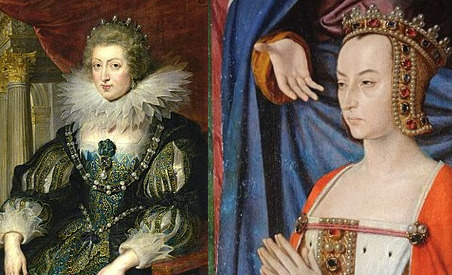
Anne d'Autriche:
Was a spanish habsburg born in Valadolid and, as such, princess of the Netherlands. Cause why not. She did the regency for her son Louis XIV until he became of age.
Anne:
While she wasn't officially the regent, her husband was, for her brother, so clearly she was in the influence sphere, and also she was her brother's legal tutor. She was the most powerful woman in Europe during that time, considered extremely intelligent and extremely dangerous to cross. Shaped european politics to this day.
Dates indicated are dates of regency.
18 notes
·
View notes
Text

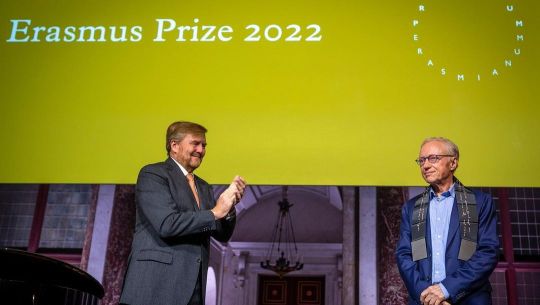
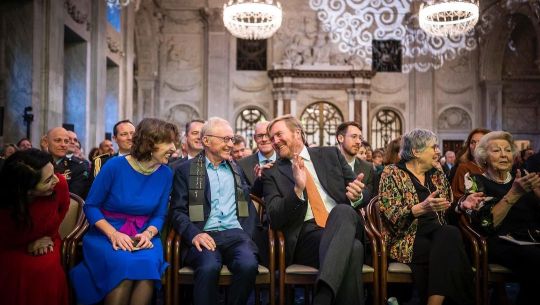


On Tuesday afternoon, 29 November, His Majesty King Willem-Alexander awarded the Erasmus Prize to the Israeli writer David Grossman (Jerusalem, 1954) in the Royal Palace of Amsterdam. The King is Regent of the Praemium Erasmianum Foundation. This year's theme is 'Connectors in a Divided World'. Queen Máxima and Princess Beatrix also were present at the ceremony.
📷 Royal House of The Netherlands
28 notes
·
View notes
Text
when: narrative
A brief overview of the history of Mecklenburg, from 1890 to 2006.
Means the person is a sole creation of me.

Heinrich Ludwig I, King of Mecklenburg, (born 26 January 1890) only child of Duke Johann Albrecht of Mecklenburg-Schwerin and Princess Elisabeth Sybille of Saxe-Weimar-Eisenach.
Princess Elisabeth Sybille died in 1908 when Heinrich Ludwig was eighteen years old. His mother was first cousin to Queen Wilhelmina of the Netherlands, making Wilhelmina his maternal first cousin once removed. Wilhelmina married Heinrich Ludwig’s paternal half-uncle, Duke Heinrich of Mecklenburg-Schwerin, making Queen Juliana of the Netherlands his half-paternal first cousin and his maternal second cousin. The events of WWII solidified the bonds between the House of Mecklenburg and the House of Orange.
Heinrich Ludwig’s father remarried in 1909 to Princess Elisabeth of Stolberg-Rossla, they would have no children and Heinrich Ludwig remained an only child.
Heinrich Ludwig’s father had been the regent for his nephew, Friedrich Franz IV, Grand Duke of Mecklenburg-Schwerin, from 1897 to 1901.
In 1915, aged twenty-five, Heinrich Ludwig, who was fourth in line to inherit the throne, overthrew his cousin, Friedrich Franz IV, along with the support of several family members due to Mecklenburg’s involvement in WWI. Grand Duke Friedrich Franz IV abdicated on 3 November 1915 and renounced the succession rights of his two sons. Heinrich Ludwig’s father also renounced his succession rights, this time in favour of his son, who then became the Grand Duke of Mecklenburg-Schwerin. Heinrich Ludwig recalled his troops and reinforced the border with Prussia. Mecklenburg effectively changed sides and begun supplying Entente troops (with little effect but the gesture was appreciated).
In early 1918, the Grand Duke of Mecklenburg-Strelitz committed suicide and Heinrich Ludwig took control of the grand duchy as the current heir was serving in the Russian Army and would later renounce his claim to the throne (the only surviving male-line was of morganatic descent and ineligible to inherit at the time).
When the German Empire and her allies lost the war in November 1918, Mecklenburg-Schwerin and Mecklenburg-Strelitz celebrated their victory.
Heinrich Ludwig had fallen for the young Princess Karola of Urach prior to the outbreak of WWI and intended to marry her. She was a member of a morganatic branch of the Royal House of Württemberg, but her mother had been a Duchess in Bavaria and Heinrich Ludwig deemed this royal connection to be strong enough to overcome the fact that her immediate family did not rule over a country.
Princess Karola was born Catholic and remained a Catholic for the rest of her life. Karola and Heinrich Ludwig married on 2 January 1919.
In the Treaty of Versailles of 1919, the Grand Duchies of Mecklenburg-Schwerin and Mecklenburg-Strelitz were joined to create the Kingdom of Mecklenburg. Heinrich Ludwig was now King and Karola his Queen.
The King and Queen now needed an heir, or several. The other men in the family had only daughters and women were not able to inherit.
A son and Crown Prince, Paul Friedrich, was born 10 September 1919, nine months after his parents wedding. A daughter, Marie Elisabeth, was born on 1 November 1921. There would be no further children.
Heinrich Ludwig and his family were popular. They were accommodating to the former Grand Ducal Family, allowing them to remain in their palaces for life, with the intention of inheriting the lands after their deaths. Instead of using Schweriner Schloss or Schloss Ludwigslust as his residence, Heinrich Ludwig had built a grand palace between Bad Doberan and Rostock, having moved the country’s capital to Rostock. He named the palace Euphemiasburg, after his ancestress Euphemia of Sweden.
Mecklenburg flourished in the years between WWI and WWII, they had not been sanctioned as the rest of the former German Empire had been and despite the troubles brought on by the Great Depression, became a minor power in Europe and an important member of central Europe, enjoying close ties with her neighbours and Baltic friends, especially Denmark and Poland.
However, there were groups of people, including governments of foreign countries who were uncomfortable with the existence of the Kingdom of Mecklenburg and her powerful King. Mecklenburg was a constitutional monarchy and had been since 1916, but Heinrich Ludwig I owned half the country as his personal property, had considerable executive powers and used them frequently to intercede with government affairs as an executive monarch and de facto upper house of government.
There were also calls for Mecklenburg to reunite with Germany. This notion became more popular after the rise of the Nazi Party, which attracted a considerable following in Mecklenburg from the early 1930s.
On 1 June 1938, the German Ambassador to Mecklenburg sent word to the King that Germany was mobilising its troops and that Mecklenburg would be occupied by morning on 2 June. The King had his children evacuate to Denmark where the former Grand Duke’s sister was Queen Consort. The former Grand Duke’s eldest daughter, Duchess Thyra of Mecklenburg-Schwerin, joined her second cousins in Denmark as she and Paul Friedrich were courting and did not want to be parted.
King Heinrich Ludwig I decided to remain in Mecklenburg to dissuade his cousin the former Grand Duke and his cousins’ sons from seeking the throne of Mecklenburg, or from being used as a puppet by Nazi Germany.
The Kingdom would be occupied by Nazi Germany for nearly seven years. The King and Queen were moved from Euphemiasburg to Schweriner Schloss and lived with the former Grand Duke and Duchess during the occupation. The King’s Government was able to function normally until 1940 when Mecklenburg was officially annexed by Nazi Germany. The country’s capital was moved back to Schwerin in 1940 where it remains to this day.
The former Grand Duke’s eldest son had joined the SS in 1931, and would be among those occupying Denmark from 1940 and disowned in 1943. The former Grand Duke’s second son and youngest daughter remained in Mecklenburg for the duration of the war.
When Great Britain declared war on Germany on 1 September 1939, Paul Friedrich, his sister Marie Elisabeth and Duchess Thyra fled to London as they feared that continental Europe was no longer safe. They remained in England for the rest of the war.
Paul Friedrich and Thyra were married at Windsor Castle on 2 October 1939. King George VI, Queen Elizabeth, Princess Elizabeth and Princess Margaret were among the guests.
Crown Princess Thyra would give birth to three daughters, also at Windsor Castle, Heinrike Franziska, on 4 June 1940, Elisabeth Mathilde, on 23 January 1942 and Marie Anastasia, on 12 October 1944.
King Heinrich Ludwig and Queen Karola learnt of their ever growing family through weekly BBC broadcasts given by their only son. King Heinrich Ludwig, faced with the possibility that he and his wife would not survive the German occupation, issued a royal decree changing the laws of succession to allow women to inherit the throne by male-preference primogeniture. In addition to this, he granted his children and grandchildren nominal dukedoms in the same way Sweden granted royal dukedoms.
From 1940 to 1945, the line of succession was:
Crown Prince Paul Friedrich, Duke of Rostock, son of King Heinrich Ludwig I
Princess Heinrike Franziska, Duchess of Ratzeburg, first daughter of the Crown Prince
Princess Elisabeth Mathilde, Duchess of Güstrow, second daughter of the Crown Prince
Princess Marie Anastasia, Duchess of Grevesmühlen, third daughter of the Crown Prince
Princess Marie Elisabeth, Duchess of Parchim, daughter of King Heinrich Ludwig I
The strong bond formed between the House of Mecklenburg and the House of Windsor during the War, and the Blitz especially, continues to this day.
After the defeat and surrender of the German forces in early May 1945, Crown Prince Paul Friedrich, Crown Princess Thyra and their children, and Princess Marie Elisabeth returned to Mecklenburg in late May, only days before Heinrike Franziska’s fifth birthday.
The King and Queen were overjoyed to see their children again and meet their grandchildren for the first time. The House of Mecklenburg had survived the war relatively unscathed.
Mecklenburg, however, did not. When the Red Army advanced through central Europe, Mecklenburg grew nervous, worried that they would be left behind by the Allies. However, some of their Baltic ports were deemed important enough to the UK, USA, and France to stand up to Russia and approximately 40% of Mecklenburg was lost to the Soviets in 1945 and the Kingdom would remain split in two until 1990.
The former Grand Duke, Friedrich Franz IV died on 17 November 1945. Heinrich Ludwig and Karola took possession of Schweriner Schloss as their pre-occupation home Euphemiasburg was now only miles from the Eastern German border. The former Grand Duchess took up residence at Schloss Ludwigslust, where she would remain until her death in 1963. She lived to see her son-in-law ascend the throne and for her eldest daughter to become Queen Consort.
Crown Prince Paul Friedrich and Crown Princess Thyra would have several more children.
Another daughter, Cecilie Auguste, Duchess of Ludwigslust, was born on 23 September 1947.
A son, Wilhelm Franz, Duke of Schwerin, was born on 17 July 1949, and was now second in line to inherit the throne after his father.
A fifth daughter, Alexandrine Luise, Duchess of Waren, was born on 18 March 1951.
A second son, Albrecht Gustav, Duke of Bad Doberan, was born on 7 October 1953.
In 1949, the King and Queen’s only daughter, Marie Elisabeth married Prince Gorm of Denmark, a grandson of Christian IX of Denmark, and they would have two children Harald, in 1953 and Feodora in 1955.
The first King of Mecklenburg died on 18 November 1954. His son ascended the throne as Paul Friedrich II of Mecklenburg with Thyra as his Queen Consort.
The new King and Queen would have one final child, Ingrid Sophie, Duchess of Teterow, born on 9 June 1955.
The new King and Queen were coronated at Schwerin Cathedral in 1956.
In 1956, the line of succession was:
Crown Prince Wilhelm Franz, Duke of Schwerin, first son of King Paul Friedrich II
Prince Albrecht Gustav, Duke of Bad Doberan, second son of King Paul Friedrich II
Princess Heinrike Franziska, Duchess of Ratzeburg, first daughter of King Paul Friedrich II
Princess Elisabeth Mathilde, Duchess of Güstrow, second daughter of King Paul Friedrich II
Princess Marie Anastasia, Duchess of Grevesmühlen, third daughter of King Paul Friedrich II
Princess Cecilie Auguste, Duchess of Ludwigslust, fourth daughter of King Paul Friedrich II
Princess Alexandrine Luise, Duchess of Waren, fifth daughter of King Paul Friedrich II
Princess Ingrid Sophie, Duchess of Teterow, sixth daughter of King Paul Friedrich II
Princess Marie Elisabeth, Duchess of Parchim, daughter of late King Heinrich Ludwig I
Prince Harald of Denmark, son of Princess Marie Elisabeth
Princess Feodora of Denmark, daughter of Princess Marie Elisabeth
The line of succession was well secured, and the royal family’s standing within Mecklenburg would be credited with maintaining the stability of the small Kingdom.
The King and Queen enjoyed enormous popularity and a very happy home life. According to the rules of succession, their children were only allowed to marry people from royal or noble families and from the early 1970s, their daughters began marrying foreign born princes and having children of their own.
Queen Karola outlived her husband by several years and was able to see several of her great-grandchildren born before she died in 1980, aged 83.
Unknown to the family at the time, but 1980 was the beginning of several years of loss and difficulty for the family.
Queen Thyra died suddenly on 27 September 1981 following a severe heart attack. The country, still reeling from the death of their beloved Karola, was plunged into mourning once more. King Paul Friedrich II was beside himself with grief and the trouble concerning his youngest son wasn’t doing his health any favours.
In 1981, the Crown Prince, now 32 years old, was still unmarried and his younger brother, Albrecht Gustav, had set his sights on Veronica Doncaster, an American born commoner with Mecklenburgish ancestry. The King disapproved and refused to declare such a marriage dynastic or relax the rules regarding the line of succession. If Albrecht Gustav and Veronica were to marry, the Prince would lose his place in the line of succession for himself and his descendants, and any children would not be able to inherit the many titles used by the Royal House of Mecklenburg.
King Paul Friedrich II of Mecklenburg died 12 January 1982, outliving his wife by only a few months.
His eldest son ascended the throne as King Wilhelm Franz I of Mecklenburg. Albrecht Gustav was now his brother’s heir presumptive.
Wilhelm Franz did not have any problem with members of his family marrying commoners and changed the rules of succession and the house rules to allow unequal marriages. Albrecht Gustav and Veronica were married at Schwerin Cathedral on 29 August 1982. Veronica became a Princess of Mecklenburg and Duchess of Bad Doberan. The public, who had been supportive of their prince marrying a commoner, were thrilled and hundreds of thousands of people lined the streets of Schwerin to celebrate the wedding.
Albrecht Gustav and Veronica became parents on 27 May 1983, when a son, Paul Ludwig was born. They would have another child, Marie Leopoldine, born 3 February 1985, before moving to Canada in August 1985 to serve as Mecklenburg’s Ambassador to Canada. A further two children would be born while living in Canada, Christian Franz, born 7 March 1987 and Marie Josefine, born 27 January 1989.
In 1981, at the wedding of his cousin Prince Harald of Denmark to Duchess Helene of Oldenburg, King Wilhelm Franz I met the bride’s cousin, Princess Eleonora of Leiningen. Eleonora, born 12 May 1961, was almost thirteen years younger than the King, but they began a relationship in late 1981 and became engaged in 1984. When the couple were married in October 1985, the small Kingdom hosted a celebration like none they had seen in decades.
The new Queen settled into her role, supporting her husband and charitable causes in the years leading up to the collapse of the Soviet Union.
The King and Queen welcomed their first child, Karolina Augusta, Duchess of Elde, on 15 September 1988. From the young princess’s birth there was rumblings of changing the laws of succession to allow the eldest child to inherit regardless of gender.
On 15 September 1989, Karolina Augusta’s first birthday, the King granted his daughter the title Duchess of Rostock (a title previously held by her grandfather, King Paul Friedrich II) and announced his intention to change the laws of succession from 1 January 1990 among his descendants to absolute primogeniture and thus his daughter would become Crown Princess and the heiress apparent.
So, on 1 January 1990, King Wilhelm Franz I issued a royal decree changing the laws of succession and his daughter became the Crown Princess of Mecklenburg and the first heiress apparent in the country’s almost 900 year history.
Following the fall of the Soviet Union, the former lands of Mecklenburg were reunited and a referendum held on 14 October 1990 led to the incorporation of the lands of Vorpommern, almost doubling the size of the Kingdom of Mecklenburg. On 15 October, King Wilhelm Franz I announced that to honour Vorpommern he had changed his eldest daughter’s surname from von und zu Mecklenburg to von und zu Mecklenburg-Vorpommern. Karolina Augusta was now the head and founder of the House of Mecklenburg-Vorpommern, designated as a branch of the House of Mecklenburg.
From late 1990, the King and Queen started the long and arduous task of rebuilding their nation and welcoming their new subjects into a thoroughly western nation after decades of Soviet rule.
During an annual ski holiday to Switzerland, the King died following a skiing accident on 20 January 1992. Wilhelm Franz was only forty-two years old and had reigned for just over ten years.
His only child ascended the throne as Queen Karolina Augusta I of Mecklenburg. She was three and a half years old.
Queen Eleonora, who was seven months pregnant, was declared regent on 21 January 1992 by the Council of the Royal House and Family of Mecklenburg. The late King’s younger brother, Albrecht Gustav, who had been serving as the Mecklenburgish Ambassador to Canada, attempted to have himself declared regent, but was unsuccessful. Albrecht Gustav became resentful and refused to return to Mecklenburg once his term as Ambassador to Canada finished in 1993.
Queen Eleonora, now aged thirty-one, gave birth to a son, Klaus Wilhelm, Duke of Havel, on 12 March 1992.
The regency would last over fourteen years, until Karolina Augusta turned eighteen on 15 September 2006.
The rules regarding the line of succession where changed further in late 2006, to overturn the rule only allowing Protestants. This allowed the Catholic children of Princess Feodora into the line of succession.
The line of succession was now:
Prince Klaus Wilhelm, Duke of Havel
Prince Albrecht Gustav, Duke of Bad Doberan
Prince Paul Ludwig of Mecklenburg
Prince Christian Franz of Mecklenburg
Princess Marie Leopoldine of Mecklenburg
Princess Marie Josefine of Mecklenburg
Princess Heinrike Franziska, Duchess of Ratzeburg
Princess Elisabeth Mathilde, Duchess of Güstrow
Prince Ludwig of Hohenlohe-Langenburg
Princess Juliana of Hohenlohe-Langenburg
Princess Lucinda of Hohenlohe-Langenburg
Prince Konstantin of Hohenlohe-Langenburg
Princess Marie Anastasia, Duchess of Grevesmühlen
Prince Karl Viktor of Hesse-Kassel
Prince Otto of Hesse-Kassel
Prince Ernst Albert of Hesse-Kassel
Prince Nikolaus Emmanuel of Hesse-Kassel
Princess Cecilie Auguste, Duchess of Ludwigslust
Prince Friedrich Magnus of Schwarzburg
Princess Anne Therese of Schwarzburg
Princess Alexandrine Luise, Duchess of Waren
Princess Ingeborg of Schleswig-Holstein-Sonderburg-Glücksburg
Princess Sigrid of Schleswig-Holstein-Sonderburg-Glücksburg
Princess Ingrid Sophie, Duchess of Teterow
Princess Marie Elisabeth, Duchess of Parchim
Prince Harald of Denmark
Prince Oskar of Denmark
Prince Axel of Denmark
Princess Louisa of Denmark
Princess Feodora of Liechtenstein
Prince Adam Karl of Liechtenstein
Prince Peter Gregor of Liechtenstein
Princess Bernadette Sophia of Liechtenstein
Princess Johanna Eleonore of Liechtenstein
2 notes
·
View notes
Text

The Art Collection of Archduke Leopold Wilhelm in Brussels (ca. 1650-52) Oil on canvas, [Kunsthistorisches Museum, Vienna, Austria] David Teniers the Younger (Flemish; 1610 - 1690)
In the first half of the 17th century, the affluent citizens of Brussels and Antwerp became interested in establishing their own private galleries. They were inspired in this desire by a celebrated model, one, however, that they could never hope to match: the collection begun in the early 17th century by the Spanish regent in Brussels. Parallel to this, and only in the southern Netherlands, a type of painting developed in which picture galleries were shown. During his regency (1647–1656), the most important Habsburg collector, Archduke Leopold Wilhelm, assembled some 1400 paintings. This view of his gallery is likely fictitious in part because the high room with windows on the left is probably not exactly like any space that existed at the time. The size and proportions of some of the decoratively hung pictures have been altered, in reality, they could never have been hung in that combination. Here David Teniers, chamberlain, court painter and keeper of the archduke’s art collection, is accompanying the scholarly collector on a visit to his gallery. On the left, other visitors are grouped around a table, among them the diminutive castle chaplain, painter and later gallery director Antonius van der Baren. Among the elements often found in views of picture galleries are the paintings propped up in the foreground and the opening of the perspective to the rear, sometimes through a door or, as here, through large windows. Early examples of this type sometimes feature Christian didactic content, conveyed by a selection of pictures depicted in miniature; the portraits of Leopold Wilhelm’s gallery (nine in all), however, serve a purely ostentatious purpose. The one now in Vienna was sent to Prague by the brother of its owner, Emperor Ferdinand III, as evidence of the wealth of the archduke’s picturegallery. Most of the 51 Italian works shown in this painting are today in the Kunsthistorisches Museum (Vienna).
3 notes
·
View notes